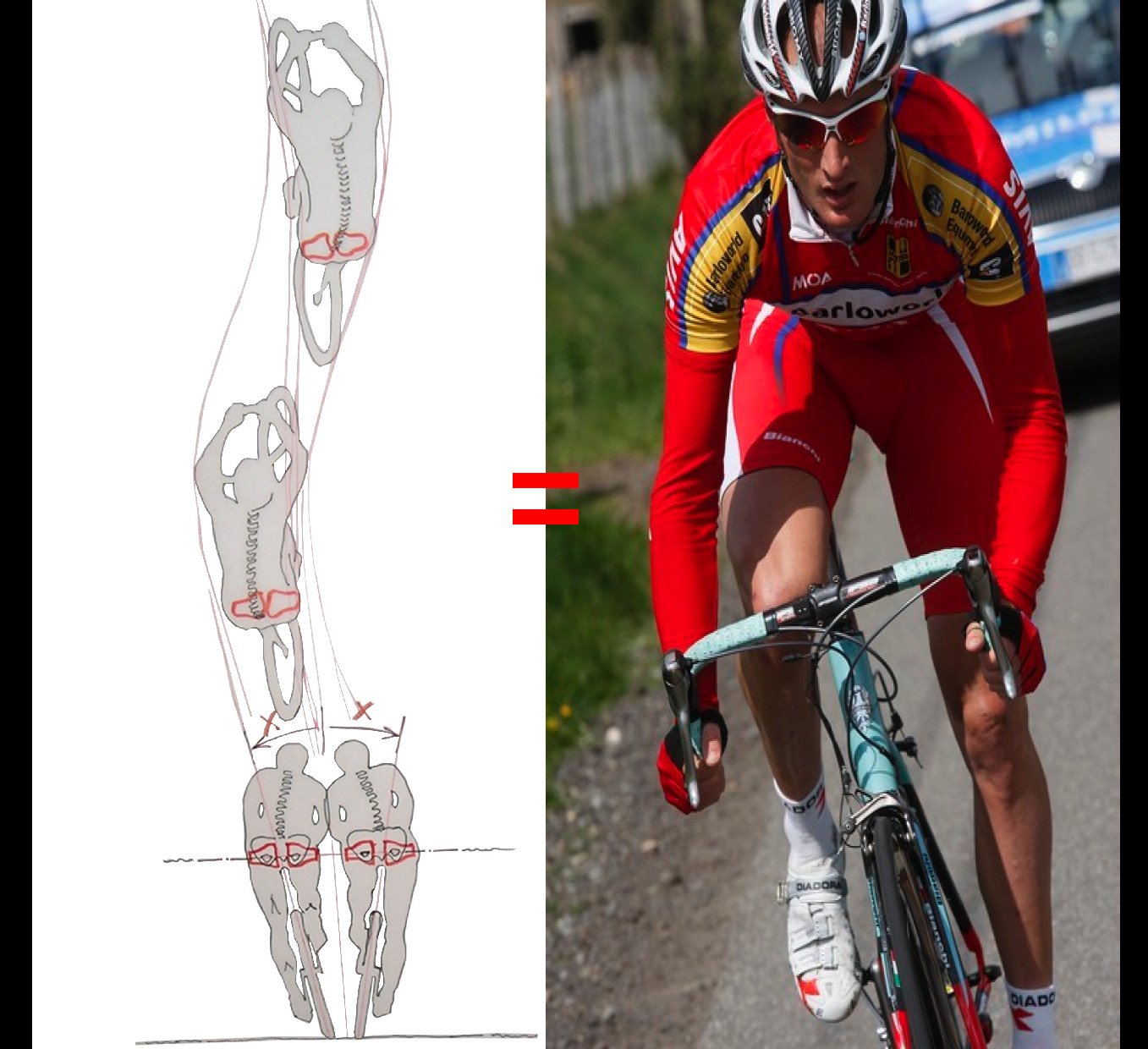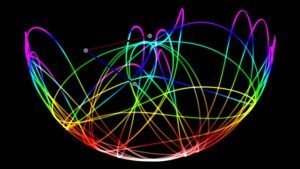We have basically two kinds of body mechanics, two ways how to move, generate or transfer power:
With a wave, you accumulate power from all over your body into one moment (like a whip).
Wave flows straight or oscillates like a pendulum/ metronome (e.g. walking).
However, using wave is not so easy… It demands skills like a relaxed body or a good internal feeling. Also, the wave needs precise body coordination. Therefore many people use the mechanical way, rather than the wave (which needs to be practised).
An awareness of wave helps you to integrate them into your everyday life.
Studying it methodically helps you to improves the flow and efficiency of your habitual movements (e.g. throwing, walking, dancing). It will also affect your speed and power.
Through the study of the wave, you will learn to read other people’s waves.
It lets you see how somebody accumulates their energy – thus you can predict their actions, or hide your own intentions.
When you have mastered synchronising with your own body, and that of your training partner through the wave, you can synchronise your movements (waves) with more people around you…
Wave is a gate to other more gentle internal forces (Qi/Chi, Prana).
New experience, knowledge and skills acquired through System of Motion are more than handy in any real-life situation, such as dance, sports and martial arts.
Waves mechanically break down crystallised rigid structures. It is the same as waving with a frozen towel breaking its crystals, waving with crystallised tissue.
The same happens with tissue of our bodies – fasciae, muscles, tendons and ligaments. Therefore, if, for example, we have a stiff neck, we wiggle and save around the neck and shoulders to help us. If we know it, we can consciously heal ourselves and keep our bodies supple and youthful.
I still remember how my grandma uses to push me in the swing. She used to swing me for hours.. She was tireless, now I understand why: because she  had a feeling for when to push me at the right moment – in harmony with kinetic energy – efficiently – with a tiny amount of energy.. Her touch was so soft.. yet energy built and I would swing higher and higher.
had a feeling for when to push me at the right moment – in harmony with kinetic energy – efficiently – with a tiny amount of energy.. Her touch was so soft.. yet energy built and I would swing higher and higher.
Finally, I freed myself – I learned to use my own kinetic energy (shifting weight at the right time – harmonising with the pendulum.
The pendulum is really interesting energy, which deserves our focus..
Kinetic energy without the influence of any other power flows straight. If another power is involved, it can start to oscillate between forces. During oscillation kinetic energy transforms into potential energy.
Potential energy doesn’t need to flow straight back, the potential energy can be used later – as stored energy (e.g. if you stay on the top of the U ramp, or a skier on top of the hill).
The pendulum is an efficient way of moving mass with a small amount of energy.
To keep the pendulum moving, we just need to compensate for the energy lost by friction.

This energy helps us to walk, stand up, pull, push or throw.
 Kinetic/potential energy helps us to measure time (e.g. clock, watch) or it can crash (e.g. battering ram, demolition machine, punch, kick, body-check )..
Kinetic/potential energy helps us to measure time (e.g. clock, watch) or it can crash (e.g. battering ram, demolition machine, punch, kick, body-check )..
We can also use a natural pendulum to generate electricity (wave power; oscillate: wind – gravitation) or wind spring (self-winding watch; oscillate: gravitation – energy from hand movement).
Pendulum movement can also increase our vital energy.
How does the pendulum force affect the human body?
Many waves of potential & kinetic energies flow through our bodies. All these energies influence each other. If we move dynamically, it can be a big storm of kinetic waves flowing across each other.
The energy can synergise or eliminate itself.
The same occurs with our muscle power: it can prevail & absorb kinetic/potential energy, or we can surf on that energy.

How you work with kinetic energy has a massive influence on the efficiency of our movements. Your body can create a waving noise or a waving symphony.
Which kind of pendulum energy is flowing through us?
1. swinging pendulum – (e.g. arms, battering ram)
2. staying pendulum – metronome (e.g. walking body, U ramp)

It’s easier to go forward by a wave than linearly. Oscillation can feed our movement. In this case, it creates counter-power to let him push stronger to the pedal.
3. rotating pendulum (e.g. hips/chest rotation, spring in a watch)
4. bouncing pendulum (e.g. up-down oscillation in knees, spring oscillator, sea wave)
5. elastic pendulum (e.g. Achilles tendon during jumping, bowl)
Passive (inanimate objects) have a trajectory of oscillation that is predetermined.
We, as humans, are active objects – we have a free choice of moving with our:
a) pivot point (elbow, shoulder, hips, legs),
b) centre of balance (e.g. knees, hips, chest & head),
c) joints (shoulder, elbows, chest, hips etc.) – can be relaxed or fixed (solid) (elbows, knees).
Manipulation with these options lets us create infinite patterns.
Where does the kinetic energy come from?
It can be created by your muscles, by other objects, or you can easily use massive potential energy, which you create every morning when you stand uplifting your body mass against gravitation.
This potential energy can be transferred to kinetic energy by:
a) going off balance (can be any centre of balance, e.g.: feet, knees, hips, chest, head or arms)
b) turn off the supporting muscles.

The kinetic energy can be used in this basic way:
a) in phase
b) out of phase
E.g. swing one arm forward & backwards during walking forward. You are using kinetic power as a pendulum when your arm is moving forward (in-phase – arm is pulling you), but you also use the kinetic energy when your arm is moving backwards (out of phase – the arm gives the body rotational energy [around a shoulder]).
We can also change the period of oscillation – rhythm (e.g. according to a partner/opponent or in time to the music). E.g. if a passive object has a period of oscillation of 1 second, using your movements you can change it for 1.5s, 0.5 s, (or to an even shorter period of oscillation (e.g. 0.1 s) – vibration).

Animation of two waves, the green wave moves to the right while the blue wave moves to the left, the net red wave amplitude at each point is the sum of the amplitudes of the individual waves. Note that f(x,t) + g(x,t) = u(x,t)
Source Wikipedia
To keep momentum working, you need to apply just a small amount of power at the right time. The first condition to connect with the kinetic energy is feeling – you need to feel the energy (you can also see it, how it flows through a body). Then, if you feel it, you need to synchronise your muscles to work with the flow of the pendulum. It’s not easy, it demands quite precise coordination (like my grandma had), but it’s possible..
The final question for you is: Is it worth it?
If you master pendulum energy, you can move your body mass with a really small amount of power & energy – you are more efficient, quicker & stronger..
How to train using kinetic energy?
Practically everybody has developed this ability on some basic level.. Repeating the same activity many times leads us to naturally use kinetic/potential energy. We are often developing the same specific moving patterns in martial arts, dancing or sports. However, in these activities, the spectrum of moving patterns is quite narrow. Therefore, it is good to eliminate patterns & flow with pendulum energy freely!
The wave releases tension, breaks down crystalised tissue and can heal us.